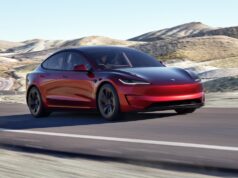Many critics have commented that Honda has “lost its way,” but could the new 2013 Fit EV that arrives next month convince the world that Honda is serious about “green vehicles?”

Honda may have been the first automaker to bring a hybrid vehicle to the U.S. with the first generation Honda Insight, over a decade ago, but today Toyota’s Prius and the rest of its hybrid models overshadow most of Honda’s efforts. Many critics have commented that Honda has “lost its way,” but could the new 2013 Fit EV that arrives next month convince the world that Honda is serious about “green vehicles?”

How Does it Look?
The 2013 Honda Fit EV is Honda’s answer to the Nissan LEAF EV and Ford Focus Electric. Honda chose to develop its new electric car on the existing Honda Fit platform rather than create a dedicated model, like the Nissan LEAF. On the outside, the biggest differences are a unique front and rear fascia, which is in many ways, sportier than the standard Fit.
Honda calls the Fit EV’s exterior “efficient emotional,” as it refines the existing Fit’s form with aerodynamic upgrades that are functional and enhance the Fit’s fun to drive performance. The improved aerodynamics from the revised exterior give the Fit EV a 14% lower coefficient of drag than the standard Fit. The Fit EV’s exterior is far sportier and less goofy looking the Nissan LEAF. It remains to be seen if buyers will prefer the LEAF’s unique exterior that lets other drivers on the road know that you are driving an electric car or if buyers will prefer an exterior that looks more like a standard car.
Inside the Fit EV looks pretty close to the standard Fit. The biggest differences from the driver’s seat are the new digital readout for the speedometer and the new other gauges that provide information about the Fit EV’s electric drive system. The Fit EV also gets standard climate control, a navigation system and the seats are wrapped in a new version of Honda’s Bio-Fabric. One thing that is sadly missing, is the standard Fit’s rear “magic seat,” which has been swapped out with a standard rear folding seat to make room for the battery pack. Other than that the Fit EV’s interior is just as spacious and versatile as the standard Fit’s.
What’s it Got Under the Hood?
Under the hood the Fit EV swaps out the standard Fit’s 1.5L four-cylinder for a 92 kW electric motor, 6.6 kW charger and lithium-ion battery pack. The Fit EV has a three-mode drive system (sport, normal and econ). The Fit EV was just labeled as the “most fuel efficient vehicle in the U.S.” by the EPA, which certified it with a 118 MPGe rating, which is higher than the LEAF and Ford Focus Electric. It has an EPA rated combined city/ highway driving range of 82 miles on a single charge. Using a 240-volt outlet, Honda states that it only takes less than three hours to fully recharge the Fit EV’s battery pack compared to the six-eight hours it takes other electric vehicles.
An interactive remote control with a range of up to 100 feet can also control charging and operation of the climate control system when the Fit EV is connected to a power supply. Charging can also be set to turn on when electricity rates are at their lowest level though the Fit EV’s Multi-Information Display or by the Fit EV smartphone app.
How Does it Drive?
Many car buyers would probably expect the Fit EV to be less fun to drive than the standard Fit, but thanks to the standard Fit’s already great platform, the Fit EV is more fun to drive than some of the other electric vehicles on the market. One big change for the Fit EV is the addition of an independent rear suspension compared to the standard Fit’s rear torsion beam. Honda gave us a chance to compare the Fit EV alongside the Nissan LEAF. Acceleration and slalom back to back runs of the two electric cars showed how much sportier and nimble the Fit EV is compared to the LEAF. The heavier Nissan LEAF exhibited more body roll and was slower than the Fit. Around town the Fit EV was a joy to drive with its immediate torque and three different driving modes. The Fit EV’s transmission also has a “B” range, that optimizes the amount of regenerative braking energy that is sent back to the battery.
Would We Buy One?
The first Honda Fit EV’s will start arriving next month, but Honda has chosen to launch it first in select markets in California and Oregon. Buyers on the East Coast won’t be able to get their hands on one until sometime in early 2013. Unlike the Nissan Leaf, which can be purchased, Honda will only allow buyers to lease the Fit EV at $389 a month for 36 months. Honda will also only plans to build 1,100 Fit EVs over the next two model years, which means that you will likely still see more Nissan LEAFs on the road.
With the lack of infrastructure, electric cars are still not as viable as standard cars for everyday transportation. The Fit EV and the other electric vehicles on the market are mainly for households that have more than one car in the garage. But either way, the Fit EV does prove that Honda has what it takes to build a competitive “green” vehicle. The Honda Fit EV is easily the best model in its segment. It has power and driving dynamics that you wouldn’t necessarily expect from an electric car, it has the highest fuel efficiency rating that the EPA has ever given and there aren’t any compromises on the inside.
If only Honda would build more…















